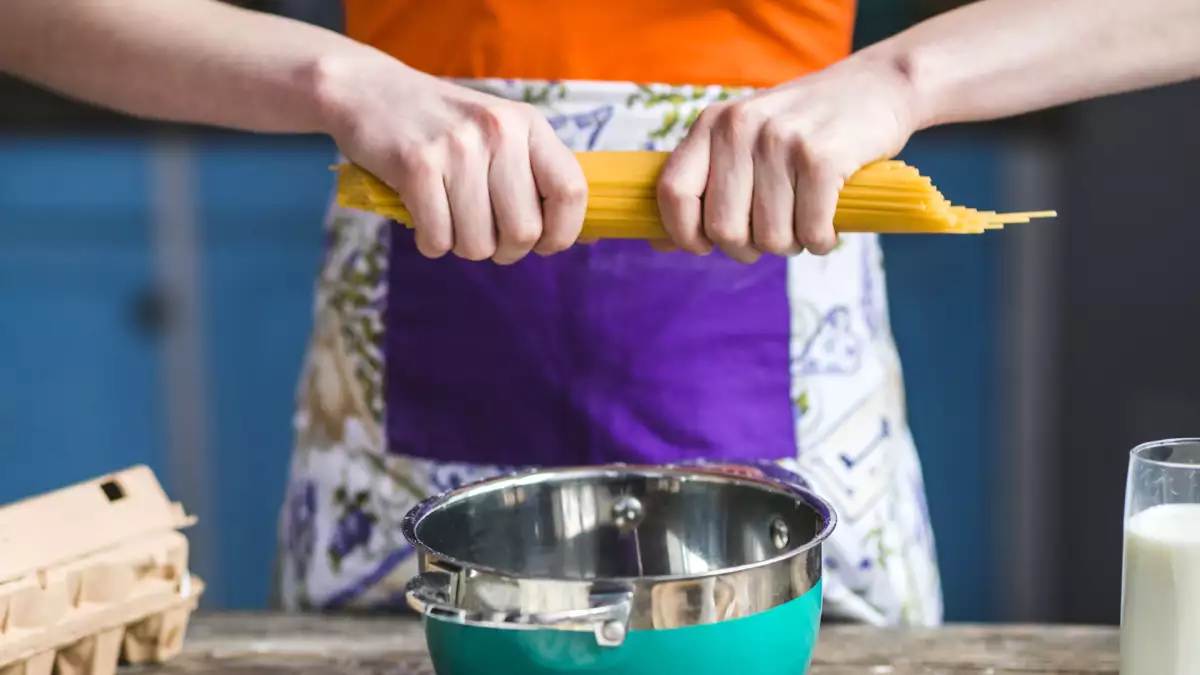Things we do with pasta that would make an Italian cry

If we say pasta, we say Italy. We all cook it, we all enjoy it... and more than one of us has unknowingly desecrated it, because pasta forgives almost everything: lack of time, ideas... even desire. Because pasta forgives almost everything: lack of time, lack of ideas... even lack of desire. Who hasn't emptied a jar of industrial pesto on some spaghetti and called it a recipe? But in this confidence, we also commit sacrileges.
From the outside, we throw ourselves into it with enthusiasm, yes, but also with a joyful unconsciousness that, seen from Italy, borders on the unforgivable. Innocent gestures such as breaking the spaghetti before boiling, for us everyday... for them, a profanation. We think we are improvising with grace and, in the meantime, in some corner of Bologna, someone is holding their hands up to their heads.
Are you sure you haven't sinned too? Here are some customs that, unknowingly, undermine the sanctity of pasta. No carabiniere will come for you, but if you dine with an Italian... you'd better be forewarned.
1. Split the long pasta before cooking it
Breaking spaghetti before cooking is one of those customs that, outside Italy, pass for practice. But in its country of origin, it is considered disrespectful. Long pasta is not broken: it is folded, twisted and accompanied. Fragmenting it is to break the balance between shape, texture and way of eating.
2. Cook the pasta until it is "soft"
If the pasta has lost all resistance, if it falls apart before reaching the fork, if you could give it to a baby without mashing it... it is overcooked. And the most serious thing: it has moved completely away from the al dente point, that subtle firmness that defines perfect cooking. Unacceptable.
3. Adding oil to the cooking water
"So it won't stick", they say. But the oil in the cooking water doesn't deliver on that promise. It just floats on the surface, doesn't keep the pasta from clumping and, worse, prevents the sauce from sticking as it should. According to some, it also arouses the silent disapproval of generations of Italian grandmothers.
4. Cut the spaghetti with knife and fork
We know: spaghetti - and other long pastas - can seem unwieldy. But cutting them with a knife and fork is not a practical solution, it's a mistake. In Italy, it's considered disrespectful to the dish. The right thing to do is to turn them with the fork until they form a small nest. And if you need a spoon for support, use it discreetly.
5. Mixing leftover pasta of different types
Half a bag of penne, some orphaned fusilli, three rigatoni left at the bottom of the package... why not put them all together? Well, because in Italy that is not how they do it. Each format has its own personality, its own ideal sauce, its own cooking time. Mixing them together is like making a collage with loose pages from different books and calling it a novel.
6. Add cream to carbonara (and call it carbonara)
This is probably the greatest sin of all. A real carbonara has no cream. No onions. No mushrooms. Just eggs, pecorino cheese, guanciale and pepper. Nothing more. Nothing less. If you add cream, call it something else: it's not carbonara. And we don't say that out of purism, but out of respect for the original recipe.
7. Sprinkle pasta with cheese without asking
It's almost a reflex: plate of pasta, shower of Parmesan. But not all of them appreciate it. Some, especially those with seafood, reject it outright. Adding cheese in such cases is not only a mistake: for an Italian, it can be bordering on offensive. Ask first. Or watch his eyes: if you see his pupils dilate, put the grater away.
8. Adding ketchup to pasta
Pesto alla genovese, rosso or calabrese. Salsa al limone, puttanesca, amatriciana, ragù alla bolognese... Italian cuisine has spent centuries perfecting its sauces. Adding ketchup to a pasta dish is not a creative license: it is an unnecessary simplification that detracts from both the product and the palate.
9. Serve the pasta as a side dish
Next to a steak, as an accompaniment to a chicken breast... pasta has been, in many foreign kitchens, reduced to the secondary role of garnish. But in the Italian tradition, pasta is always the protagonist. It is a primo piatto, with its own entity, designed to be served alone.
10. Using bread to push the pasta (without fare la scarpetta correctly)
In Italy, bread and pasta are not mixed lightly. Using it to push the spaghetti around like a shovel is an unrefined gesture that is out of place at the table. What is allowed (and celebrated) is fare la scarpetta: picking up the last bit of sauce with a piece of bread, once the dish is finished. But only at the end, and always with discretion.
11. Keep the cooked pasta in the refrigerator for another day and reheat it
Pasta is not a stew. Neither the point, nor the texture, nor the grace survive rest. Chilling cooked pasta to heat it the next day (especially if it is already mixed with sauce) transforms what was once a vibrant dish into a mushy mass with no nuances. In Italy, pasta is not reused: it is served freshly made, with just the right cooking time and the right seasoning.
12. Set the sauce aside once it is cooked
Drain the pasta, serve it on the plate and then add a spoonful of sauce on top: a common scene on many tables, but far from the correct way to prepare it. In Italian cuisine, the sauce is not added at the end, it is integrated before, in the pan, with a little cooking water and a brief sautéing that makes it all bind together.
Harmless errors or gastronomic heresies?
It's not about going around the world afraid to boil macaroni, but it is about understanding that, in Italy, pasta is not just food: it is culture, identity, almost religion. So, the next time you cook spaghetti, remember these lines. And if you decide to ignore them... at least do it with full knowledge of the facts.
 Patricia González
Patricia González
Comments